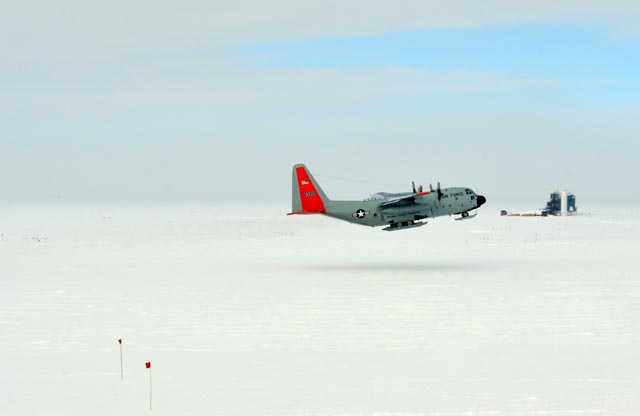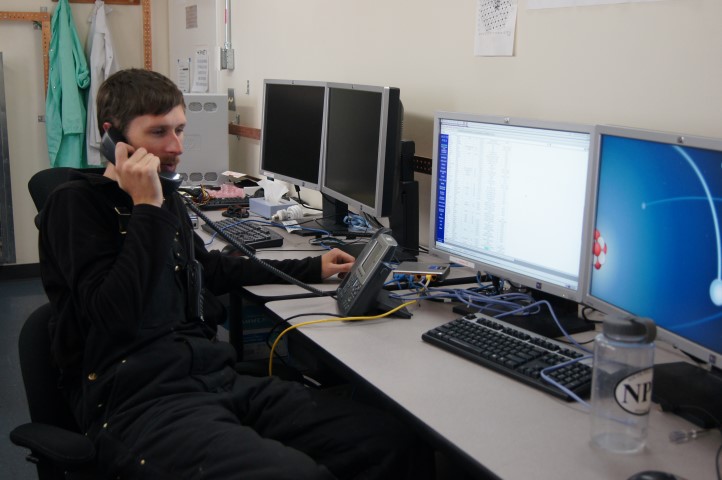|
Major upgradeBusy maintenance summer under way for IceCube Neutrino ObservatoryPosted December 20, 2013
Austral summers are not as exciting now as they once were when the IceCube Neutrino Observatory While there are no more strings deployed, the detector is performing impressively at full speed. But getting as much data as possible from this huge telescope buried in the Antarctic ice still depends on how much can be done at the South Pole during a few months with daylight and reasonable temperatures. An LC-130 Hercules 
Photo Credit: Paul Sullivan/Antarctic Photo Library
An LC-130 takes off from the South Pole Station, with the IceCube Lab in the background.
About 20 “IceCubers” will fly to the Pole this year from various locations across the United States, as well as from Canada, Germany, Sweden and Belgium. The project is a multinational collaboration studying neutrinos, nearly massless sub-atomic particles that result from the most violent astrophysical events in the universe, such as exploding stars, gamma ray bursts, and cataclysmic phenomena involving black holes and neutron stars. Last month, the IceCube Collaboration announced in the journal Science that the observatory recorded 28 very high-energy particle events that constitute the first solid evidence for astrophysical neutrinos from cosmic accelerators. [See previous article — From a galaxy far, far away: IceCube finds first solid evidence of neutrinos from outside the solar system.] It was named the top breakthrough in physics by the British magazine Physics World. [See NSF press release IceCube is comprised of 5,160 digital optical modules suspended along 86 strings embedded in a cubic kilometer of ice beneath the South Pole. The NSF-supported observatory detects neutrinos through the tiny flashes of blue light (called Cherenkov light, named after a Russian physicist who first detected it experimentally) produced when neutrinos interact in the ice. This season the IceCube Laboratory will undergo the largest upgrade of its computer system since construction was completed in December 2010. In addition to more than 5,000 optical modules in the ice sheet, IceCube consists of almost 150 computers in the IceCube Laboratory that are there for the data acquisition, filtering, transfer, and storage. 
Photo Credit: Elaine Hood/Antarctic Photo Library
Scientist Jonathan Davies works in the IceCube laboratory.
“We’re upgrading all of the data readout computers and servers, in addition to our usual calibration activities,” said John Kelley, who manages the maintenance and operation of the IceCube detector. Nearly 12,000 pounds – four crates of computers and other equipment – were shipped about 10,000 miles to the Pole for the upgrade. Aside from the summer surge of scientists, all that equipment and the associated software requires two people full-time maintaining the operation year-round, including over the dark winter months when the temperatures reach below minus 100 degree Fahrenheit, or minus 70 degrees Celsius. “IceCube is successfully taking data more than 99 percent of the time, and this high uptime depends upon maintenance of our systems during the austral summer and the hard work of the winter-overs during the whole year,” Kelley said. “In the event of a problem, the winter-overs are automatically paged, allowing them to quickly respond to the issue and keep the detector running.” This year that job falls to Dag Larsen and Ian Rees who replaced Blaise Kuo Tiong and Felipe Pedreros, the 2012–13 IceCube winter-overs. Getting everyone and everything down to the Pole involves a lot of time and peoples’ effort up in the north. A team in Madison, where the Wisconsin IceCube Particle Astrophysics Center is located, and from other places around the IceCube Collaboration, works with personnel with the USAP to assess every need and every pound of cargo. Moving people and equipment to Antarctica is expensive, but forgetting even a smallest piece can jeopardize a full season, according to Jim Haugen, who is responsible for the IceCube South Pole planning and logistics. “We don’t want to have any surprises while the season is under way,” Haugen said. Unless those surprises come from a supernova somewhere in the far-flung corners of the universe. This article was edited from the original press release here: http://icecube.wisc.edu/news/view/178 |



For USAP Participants |
For The Public |
For Researchers and EducatorsContact UsU.S. National Science FoundationOffice of Polar Programs Geosciences Directorate 2415 Eisenhower Avenue, Suite W7100 Alexandria, VA 22314 Sign up for the NSF Office of Polar Programs newsletter and events. Feedback Form |

